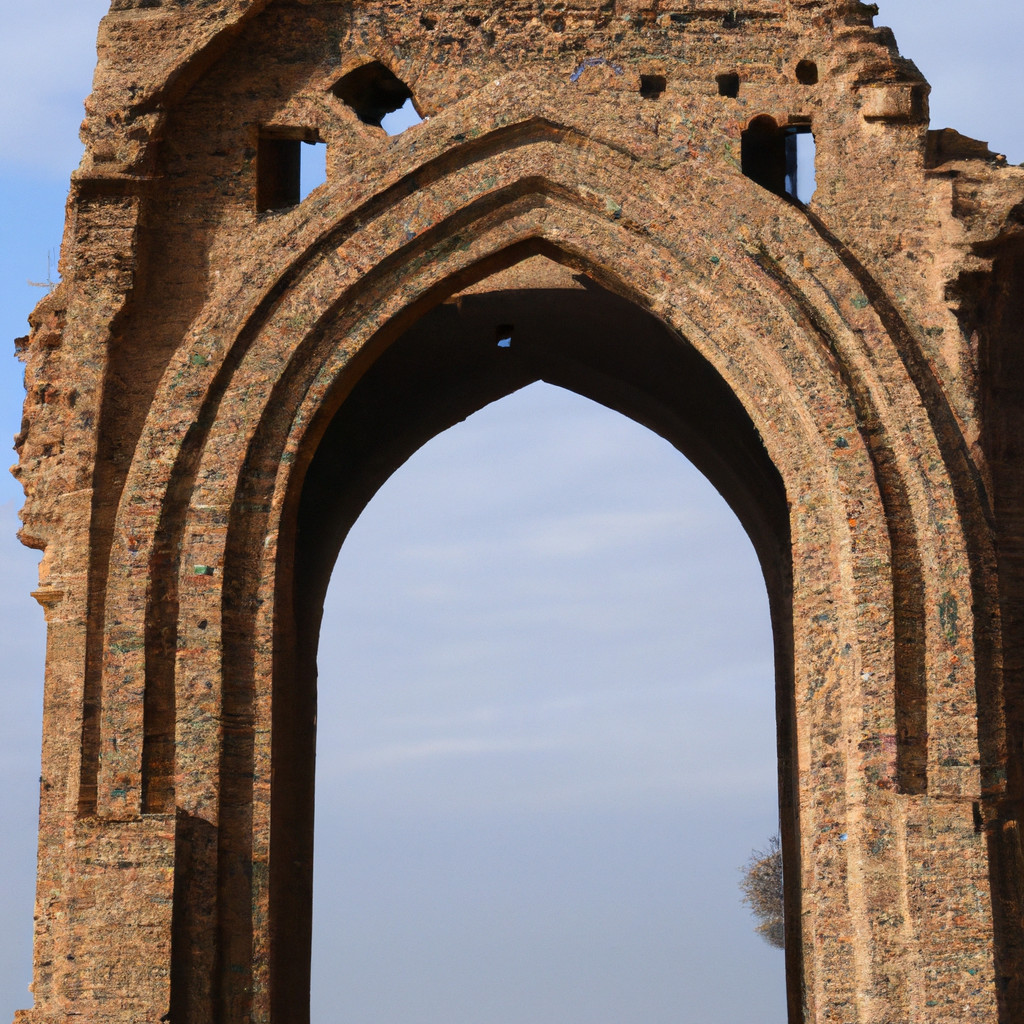Bost Arch in Lashkargah, is one of many fascinating sites that both foreign visitors and local tourists can explore while they visit Afghanistan and exploring Helmand Province. Stepping into Bost Arch is like stepping into a centuries-old Time Machine; it’s a mesmerizing spectacle of beauty and resilience, tucked away in a part of the world that’s so often misunderstood and overlooked. The timeless structure tells a captivating story, giving glimpses into Afghanistan’s long and complex history. Prominently located in Lashkargah, the capital of Helmand Province, Bost Arch is not just an architectural marvel, but also a symbol of heritage and culture in this region.
Bost Arch Most Important Events
- The establishment of Bost Arch: The magnificent Bost Arch is believed to have been built in 11th Century under the Ghaznavid Dynasty. Constructed as the northern entrance to the city, its establishment played a significant role in the urban layout of Bost, the then capital.
- Siege of Sikandar (Alexander the Great): In the footsteps of many historical invasions, Afghanistan’s integral trade location led to a crucial event at the Bost Arch. The region came under attack during the conquests of Sikhander (Alexander the Great) which left an indelible mark and shaped its history.
- Surviving the test of time: Despite numerous invasions and the ravages of time, Bost Arch has remained standing, showcasing the resilience of Afghani culture. Its persistence, in the face of countless adversities, has greatly contributed to its legacy.
History of Bost Arch in Lashkargah
Bost Arch, also known as Bost Fortress, dates back to the 11th Century during the era of the Ghaznavid Dynasty. As part of the capital city of Bost, the arch served as a northern gateway and was an integral part of the city’s architecture and urban planning. Its robust structure and strategic location were indicative of a thriving civilization that valued aesthetics, defence, and urban sophistication – a testimony to a bygone era that still echoes in its walls today.
Over the centuries, Bost Arch has witnessed countless historical events and changes in regimes. It stood tall when the region was invaded by Alexander the Great, reflecting its endurance against external invasions. The scars of battles fought long ago, are still evident on its massive red bricks, each telling a tale of survival, patience, and resilience.
Remarkably, despite its turbulent history, the arch has been preserved for over a millennium. Through invasions and the ravages of time, Bost Arch continues to be a symbol of Afghani heritage and tells the story of Afghanistan, a nation that has survived and adapted to the constantly changing political landscape.
Why It’s Important to Afghan History
Bost Arch holds massive historical significance in Afghan history. It is an impressive remnant from an important era of the Ghaznavid Dynasty, which in itself played a significant role in shaping the present-day contours of Afghanistan. The Arch is more than just crumbling bricks; it is a tangible connection to the past, narrating a tangible account of the Afghan people, culture, and heritage.
Moreover, its endurance against time and invasions stands as a powerful symbol of Afghan resilience and resolve, embodying the spirit of a nation that has withstood numerous challenges and still stands tall. It’s a testament to the Afghan’s unwavering spirit and offers a message of hope for the future.
Why to Visit Bost Arch
Nestled amidst breathtaking landscapes, Bost Arch not only offers a trip through time but provides picturesque views, making it a paradise for history buffs and nature enthusiasts alike. Its larger-than-life dimensions, archaic charm, and the stories ingrained into every brick make a visit to Bost Arch a unique cultural and historical experience.
Furthermore, the arch’s tantalizing mystery adds an allure you can’t resist. From its solitary stance in the midst of an expansive desert backdrop to the captivating details of its faded beauty, every aspect is awe-inspiring. The Bost Arch provides a stunning contrast to the raw, rugged beauty of the surrounding desert landscape.
- The site offers an incredible insight into Afghan history.
- The arch showcases unique Ghaznavid architectural features.
- The serene and isolated location provides a peaceful experience.
- The sunset views here are second to none.
- The sense of mystery surrounding its past.
It is located in the heart of Lashkargah, the access is straightforward, and the best time to visit is during winter months when the temperature is relatively cool.
Cultural & Tourist Significance
Bost Arch holds immense cultural significance for the local population and tourists alike. It’s not just an ancient structure, but a symbol of their identity and a tangible link with their past. Locals take pride in their history and heritage that the arch represents, offering silent stories of battles fought and victories won.
As a tourist destination, Bost Arch attracts a plethora of history enthusiasts and cultural explorers from around the world, eager to delve into the annals of vibrant Afghan history. The tranquility of the site, coupled with its historical backdrop, offers a unique, immersive experience for every visitor.
Even though presently marred by political instability, the significance of Bost Arch remains intact for travelers seeking immersion in authentic heritage. Visiting Bost Arch also supports local communities and contributes to the conservation and preservation efforts of this important historical site.
Interesting Facts
Despite being a significant site, the Bost Arch remains shrouded in many mysteries. It’s said that the arch is home to guardian spirits, protecting the legacy of Afghan history from the forces of time. These legends, combined with the physical evidence of survival against numerous invasions, give the arch an aura of invincibility.
Secondly, the Arch’s strategic location and robust design also suggest that the place was designed not only for aesthetics but for defence against invaders. The permutations of possibilities surrounding the true reasons for its creation, invoke intrigue and allure shrouded in mystique.
Lastly, due to the complex and sustained history behind this site, Bost Arch is often considered the symbol of Afghan resilience. It stands as a testament to the challenges Afghanistan has faced and the indomitable spirit it embodies in its resistance. The Arch is a constant reminder of the nation’s resilience, its culture, and its people.


